Tech Meets Style: How Smart Clothing is Revolutionizing Men's Fashion in 2025
Experience Smart Clothing for Men in 2025. Discover top insights, from wearable tech to eco-friendly fabrics, for a cutting-edge wardrobe. In the ever-evolving world of fashion, 2025 marks a significant milestone where technology and style converge to redefine men's apparel. Smart clothing, once a futuristic concept, has become a reality, offering functionality without compromising aesthetics. This article delves into the realm of tech-infused fashion, exploring its impact on men's wardrobes, the technology behind it, and how to incorporate these innovative pieces into everyday wear.
Table of Contents
Toggle1. Introduction
Before we begin, it’s important to note that these insights cater to a wide range of lifestyles. Some men might prioritize comfort and sustainability, while others might be more interested in performance metrics or futuristic aesthetics. Regardless of your preference, you’ll find plenty of actionable advice and inspiring ideas to help you navigate this emerging field. Get ready to revolutionize your closet with cutting-edge garments that do more than just look good—they’ll also keep you connected, protected, and performing at your best.
In this comprehensive guide, we’ll delve into 10 Key Insights that highlight how smart clothing has evolved and why it’s set to dominate men’s wardrobes in the near future. By exploring everything from climate-adaptive fabrics to advanced fitness monitoring, you’ll discover how Smart Clothing for Men can redefine the way you dress for work, leisure, and workouts. Whether you’re a minimalist seeking discreet tech features or a bold dresser who loves innovative designs, there’s something here for everyone.
Smart Clothing for Men has transformed the way we approach style, comfort, and technology. In the early days of wearable tech, men typically relied on gadgets like smartwatches or fitness trackers to enhance daily routines. However, the rapid evolution of fabrics and sensors has opened up new possibilities—garments can now regulate temperature, track biometrics, and even charge your devices. As we look ahead to 2025, the intersection of high-tech innovation and men’s fashion continues to expand, providing endless opportunities for both style enthusiasts and tech-savvy individuals.
2. Understanding Smart Clothing
Smart clothing—sometimes referred to as e-textiles, intelligent garments, or tech-infused apparel—represents a significant leap from conventional fashion. At its core, smart clothing integrates digital components directly into the fabric. These components can include sensors, conductive threads, microprocessors, and other advanced technologies that allow the garment to perform specialized functions.
What Makes Clothing “Smart”?
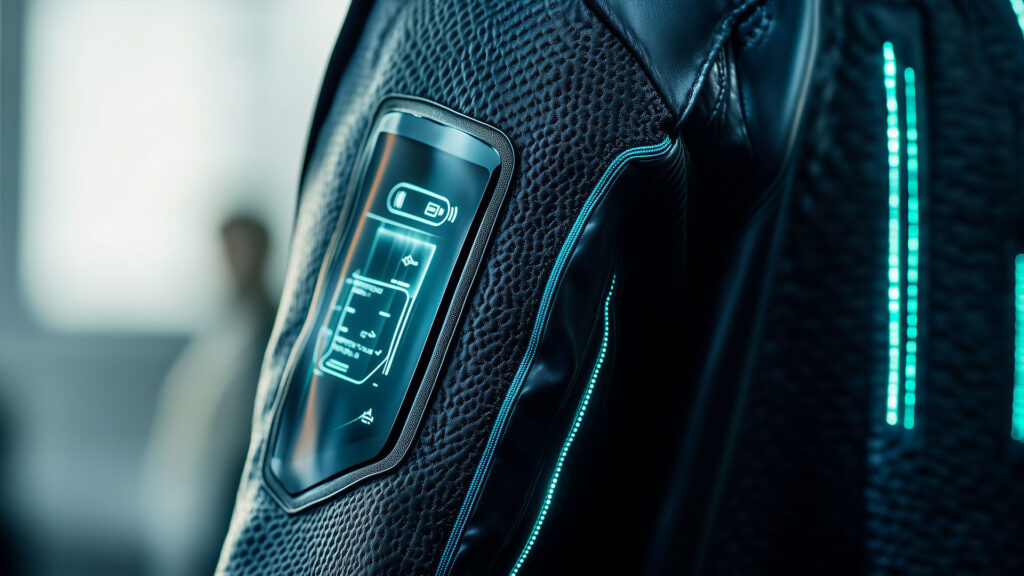
- Embedded Sensors
Tiny sensors woven into the garment track various metrics, from body temperature and heart rate to environmental factors like UV exposure. This data is then transmitted to an app or stored for later analysis. - Conductive Materials
Specially designed conductive threads and fabrics enable electrical signals to move seamlessly through the garment. This ensures that data collection and communication happen without bulky wires or external attachments. - Microprocessors & Chips
These serve as the “brain” of the garment, processing real-time data and communicating with your smartphone or other devices via Bluetooth, Wi-Fi, or NFC. - Battery or Energy Harvesting
While some garments rely on small, rechargeable batteries, others use innovative methods like kinetic or solar energy to power their internal systems.
Why It Matters for Men’s Fashion
Historically, fashion for men often emphasized functionality over flair. Smart clothing combines both, offering practical benefits—such as health monitoring or climate control—without sacrificing style. For men who value convenience and efficiency, smart garments represent the future of everyday wear. Imagine heading out for a jog and having your shirt provide real-time feedback on your performance. Or, picture a jacket that automatically warms up on a chilly morning commute, ensuring comfort without the need for extra layers.
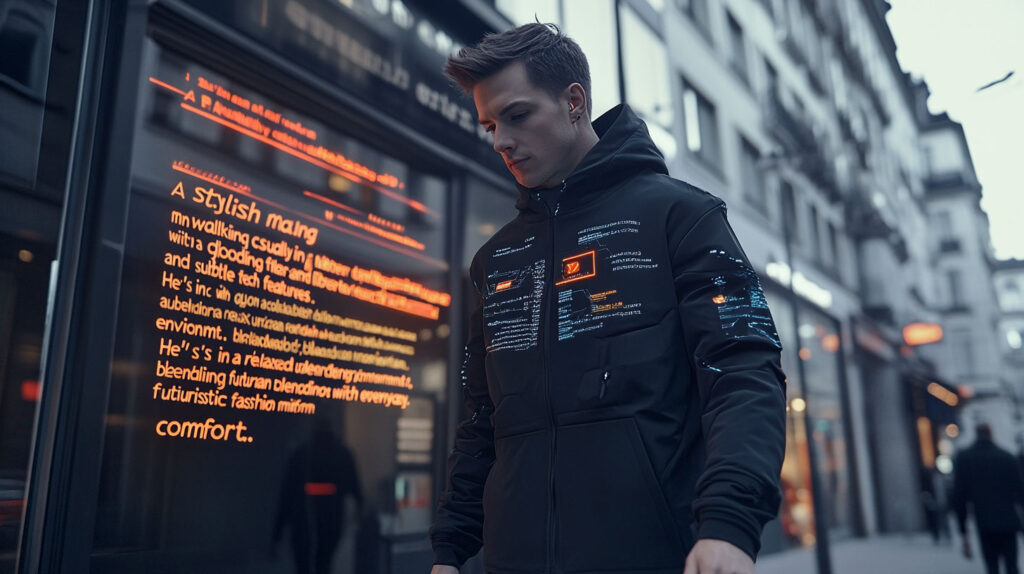
In addition, the aesthetic appeal of smart clothing has evolved significantly. Early prototypes often looked bulky or overtly “techy,” but modern designs seamlessly blend with classic silhouettes. Today, you can find everything from smart denim jackets that pair with your phone to refined business suits that discreetly monitor posture. As we progress further into 2025, expect these garments to become even more integrated, subtle, and stylish.
3. The Rise of Tech-Infused Apparel
When wearable technology first entered mainstream consciousness, it largely took the form of standalone devices—think smartwatches, fitness trackers, or clip-on sensors. The natural next step was to merge these functionalities directly into clothing, reducing the need to juggle multiple gadgets. By embedding technology in garments, designers effectively created “wearable ecosystems” that address everyday needs in a more integrated way.
From Gadgets to Garments
- Fitness Trackers to Activewear
As men’s fitness goals evolved, so did the technology supporting them. Fitness trackers once worn on the wrist have now been replaced or complemented by smart activewear that provides more precise data. - Smartwatches to Smart Jackets
While smartwatches remain popular, smart jackets offer new levels of convenience. Features like gesture controls, GPS navigation, and built-in microphones make it possible to answer calls, adjust music, or get directions with just a swipe on your sleeve.
Major Players in the Industry
The integration of technology into clothing is not limited to startup brands. Major corporations like Google, Apple, and Samsung are collaborating with well-known fashion houses to produce advanced apparel lines. These partnerships bridge the gap between tech innovation and fashion expertise, resulting in garments that are both functional and fashionable.
- Google’s Project Jacquard
This collaboration with Levi’s led to a denim jacket that allows wearers to control their smartphone through touch-sensitive fabric on the sleeve. - Nike’s Self-Lacing Sneakers
Inspired by sci-fi classics, Nike introduced shoes that tighten or loosen themselves based on the wearer’s foot shape and activity. - Ralph Lauren’s Tech Polo
Ralph Lauren experimented with biometric shirts that track heart rate and respiration, particularly popular among athletes seeking high-performance data.
Cultural Shift Toward Tech-Enhanced Lifestyles
As technology becomes increasingly intertwined with daily life, men have grown more comfortable with the idea of wearing smart apparel. Smartphones are now ubiquitous, and wireless earbuds are commonplace—smart clothing is simply the next step in this tech adoption curve. This cultural shift has opened the door for new, innovative solutions that solve everyday problems or enhance experiences, whether it’s commuting, working out, or socializing.
External Link
For more detailed reports on wearable technology trends, visit Wired’s Wearable Tech Section.
4. Key Features of Smart Clothing
In this section, we break down the fundamental elements that set smart clothing apart from traditional apparel. Understanding these key features will help you determine which items best suit your lifestyle and needs.
a. Wearable Technology Integration
Benefits:

- Discreet Functionality: Unlike a smartwatch or fitness band, smart garments often look and feel like regular clothing.
- Convenient Interaction: Control music, answer calls, or track health data with minimal fuss.
- Unified Aesthetic: No need to juggle multiple accessories or compromise on style.
Real-World Example:
A business shirt with built-in sensors can detect sweat levels and body temperature, automatically adjusting your office’s smart thermostat or alerting you to hydrate more frequently.
b. Health and Fitness Monitoring
Definition: This aspect focuses on garments that track and analyze various health metrics, from step count to muscle engagement. Advanced sensors can even detect subtle shifts in posture, alerting you to potential injuries before they become serious.
Benefits:
- Real-Time Feedback: Ideal for men who are serious about their fitness goals.
- Injury Prevention: Early detection of poor form or posture can reduce the risk of chronic injuries.
- Holistic Health Insights: Some smart clothing integrates with nutritional apps, sleep trackers, and mental health platforms for a complete well-being overview.
Real-World Example:
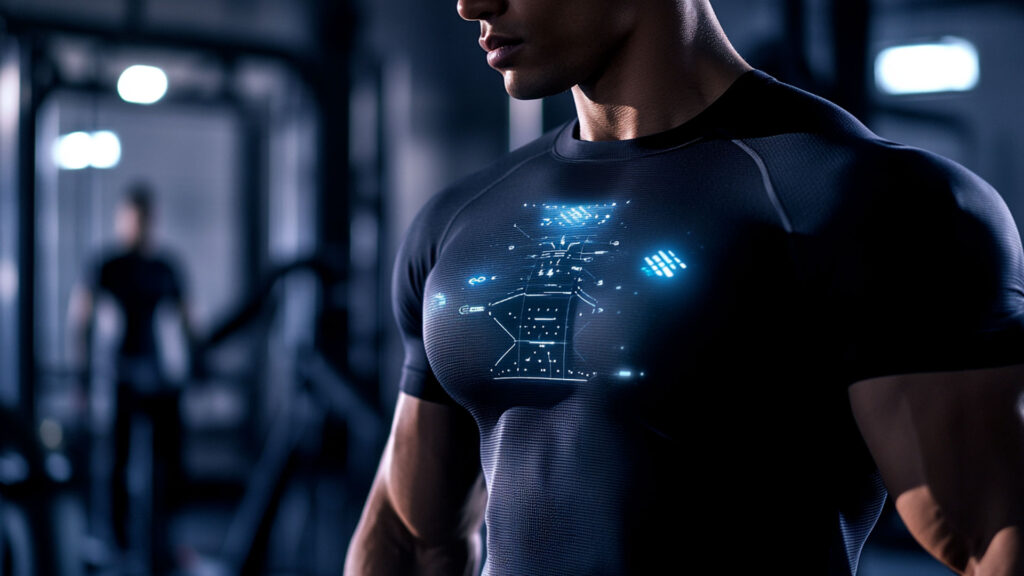
Intelligent compression shirts used by professional athletes often track muscle vibration, force, and tension, helping trainers tailor workouts to maximize performance and recovery.
c. Climate Adaptability
Definition: Climate-adaptive garments feature built-in temperature controls, moisture-wicking capabilities, or even embedded air circulation systems. These help regulate your body’s climate in various environmental conditions.
Benefits:
- Year-Round Comfort: One jacket can serve multiple seasons, adjusting to both hot and cold weather.
- Energy Savings: By maintaining a comfortable temperature, you may reduce reliance on external heating or cooling.
- Versatility: Perfect for men who travel frequently or live in regions with unpredictable weather.
Real-World Example:
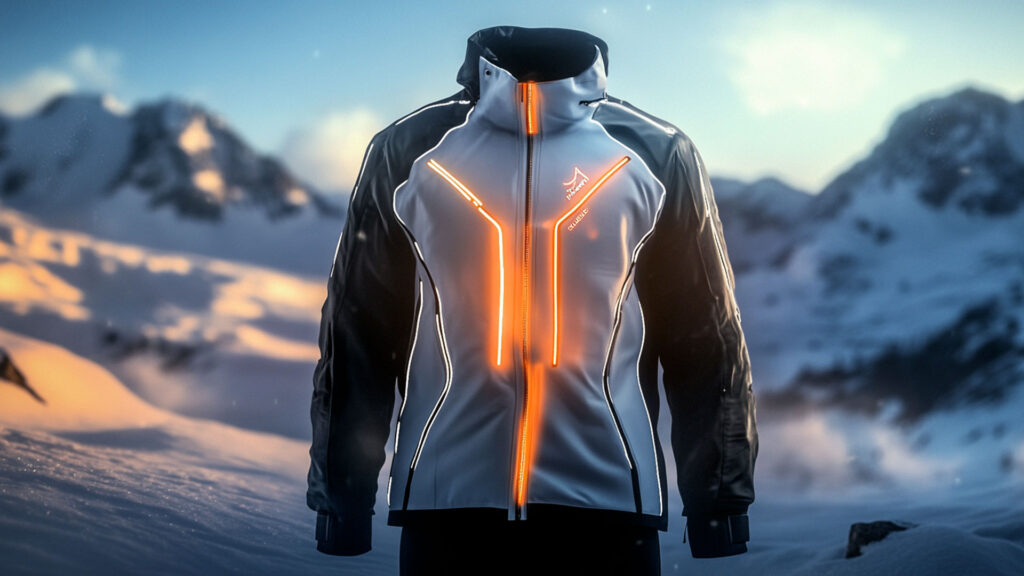
Intelligent compression shirts used by professional athletes often track muscle vibration, force, and tension, helping trainers tailor workouts to maximize performance and recovery.
5. Popular Smart Clothing Items for Men
As you explore Smart Clothing for Men, you’ll find a variety of items designed to address specific needs—whether it’s style, functionality, or performance. Below are three categories that have gained significant popularity.
a. Smart Jackets
Overview:

Smart jackets are perhaps the most recognizable form of wearable tech. They range from lightweight windbreakers equipped with LED turn signals for cyclists to stylish denim jackets with phone connectivity.
Key Features:
- Gesture Controls: Answer calls or skip songs by swiping your sleeve.
- GPS Integration: Perfect for travelers or adventurers who need directions without pulling out a phone.
- Built-In Lighting: LED strips or fiber-optic lines can enhance visibility at night.
Style Tip:
Pair a smart jacket with neutral-colored pants and minimalist sneakers to let the jacket’s tech elements stand out. This combination is perfect for an urban, futuristic look.
b. Intelligent Activewear
Overview:

For fitness enthusiasts, intelligent activewear offers an unprecedented level of insight into workouts. These garments are typically made of breathable, moisture-wicking fabrics combined with integrated sensors.
Key Features:
- Biometric Monitoring: Track heart rate, muscle engagement, and calorie burn.
- Posture Correction: Some activewear vibrates gently when you’re slouching or performing exercises incorrectly.
- Performance Analytics: Syncs with apps that provide in-depth reports on progress, goals, and recovery times.
Style Tip:
Look for designs with subtle patterns or reflective accents. This not only enhances your visibility during outdoor workouts but also adds a modern aesthetic to your gym attire.
c. Tech-Enhanced Footwear
Overview:
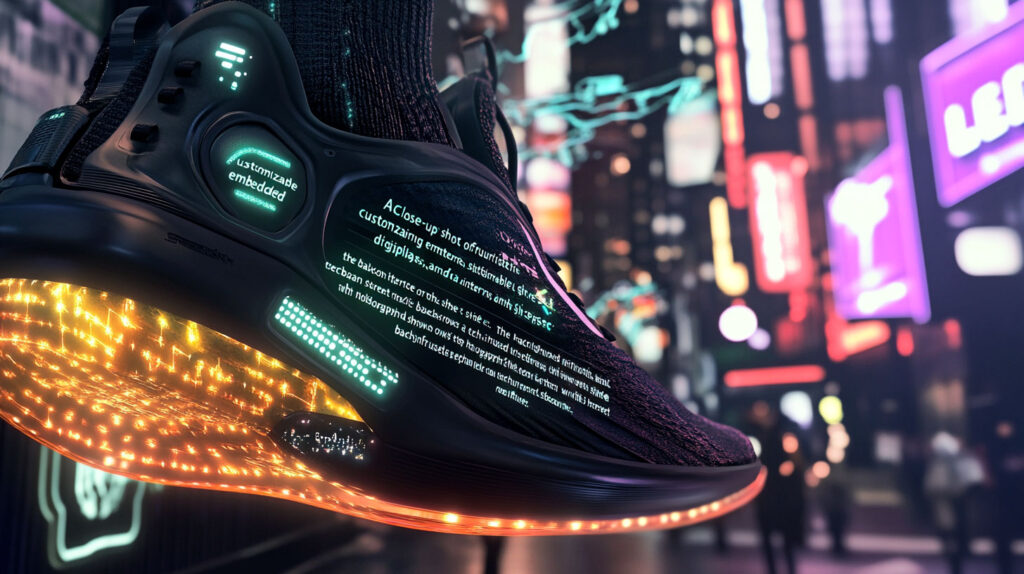
Footwear brands have embraced technology, introducing everything from self-lacing shoes to runners with integrated GPS. These innovations are ideal for men seeking optimal performance, comfort, and style.
Key Features:
Customizable Cushioning: Adjust the firmness or arch support via a companion app.
Step and Gait Analysis: Helps runners fine-tune their stride for better efficiency.
Location Tracking: Perfect for off-road adventures or marathon training, where route data is crucial.
Style Tip:
Combine tech-enhanced sneakers with slim-fit joggers and a simple T-shirt for a sleek, athleisure-inspired outfit. This look effortlessly transitions from the gym to casual social settings.
6. Incorporating Smart Clothing into Your Wardrobe
One of the biggest concerns for men considering smart clothing is how to integrate these high-tech pieces without looking out of place. Fortunately, modern designs make it easier than ever to blend innovation with personal style.
a. Everyday Casual
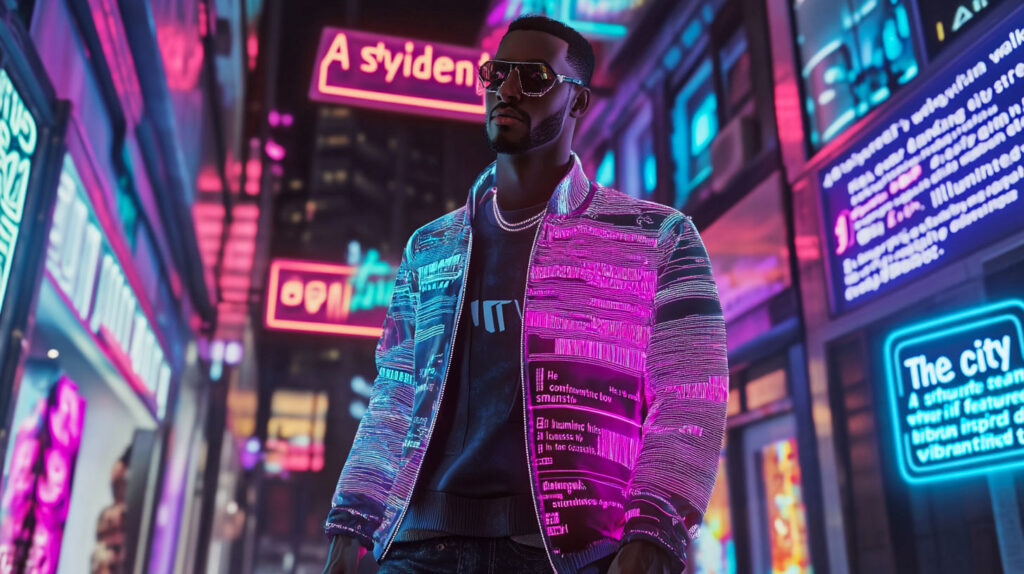
What to Look For:
- Subtle Tech Features: Hoodies or T-shirts with built-in headphone controls or discreet posture sensors.
- Breathable Fabrics: Even if it’s “smart,” it should still be comfortable enough for daily wear.
- Neutral Colors: Blacks, grays, and navy blues pair well with any outfit, letting the tech shine without overwhelming your look.
Example Outfit:
- Smart Hoodie with a small LED indicator for phone notifications
- Slim-fit jeans or joggers
- Tech-enhanced sneakers with adjustable cushioning
Benefits:
- You remain connected to calls and messages without constantly checking your phone.
- The outfit seamlessly fits into a laid-back weekend or casual Friday at work.
b. Professional Attire

What to Look For:
- Discreet Sensors: Focus on suits or dress shirts with hidden biometric or temperature-regulating features.
- Classic Silhouettes: Stick to timeless cuts—single-breasted blazers, tailored trousers—that subtly integrate tech.
- Quality Fabrics: Wool blends, cotton, or other premium materials that can conceal microprocessors without bulk.
Example Outfit:
- Smart Blazer with a built-in posture sensor and mild climate control
- Crisp dress shirt featuring moisture-wicking and odor-resistant properties
- Polished dress shoes, possibly with memory-foam insoles for added comfort
Benefits:
- Maintain a professional image while quietly benefiting from posture alerts and temperature regulation.
- Perfect for conferences, meetings, or formal events where you need to stay composed and comfortable.
Internal Link
To learn more about office-friendly tech attire, check out our in-depth guide on Modern Workwear for Tech-Savvy Professionals.
c. Fitness and Sports

What to Look For:
- High-Performance Materials: Compression fabrics that can handle sweat, movement, and sensor integration.
- Real-Time Data Feedback: Shirts or leggings that provide muscle engagement statistics, allowing for immediate form corrections.
- Recovery Insights: Some garments measure lactate levels and heart rate variability, offering personalized recovery tips.
Example Outfit:
- Intelligent Compression Shirt that monitors heart rate and oxygen levels
- Smart Shorts with integrated motion sensors for dynamic workouts
- Tech-Enhanced Footwear analyzing foot pressure and stride patterns
Benefits:
- Optimizes your workout efficiency and reduces the risk of injury.
- Helps you track progress over time, setting realistic and data-driven fitness goals.
7. The Future of Smart Clothing
While current innovations are already impressive, the future of Smart Clothing for Men promises even more groundbreaking advancements. Let’s explore what’s on the horizon as we move closer to 2025 and beyond.
a. Advancements in Fabric Technology
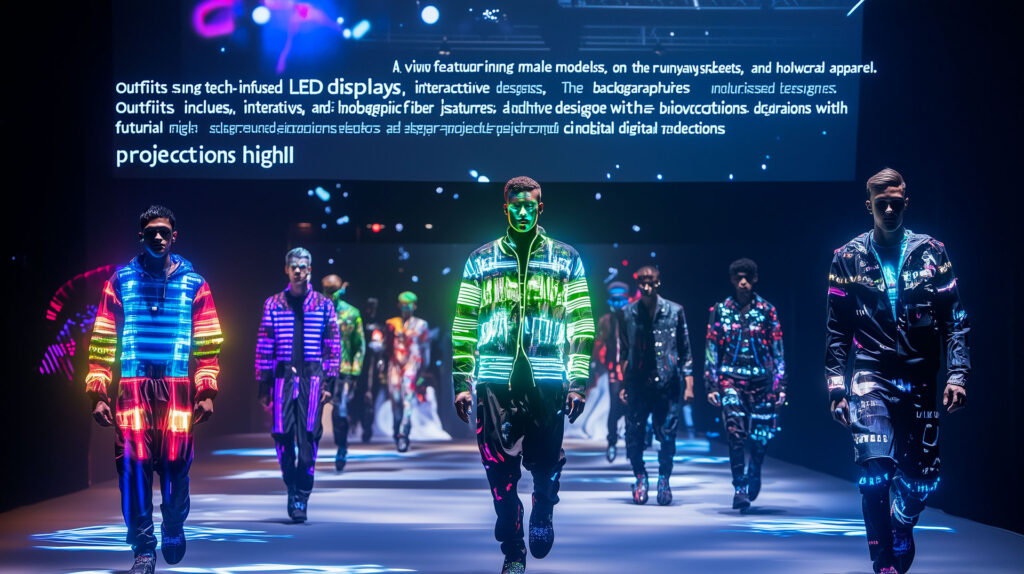
Researchers are pushing the boundaries of textile science, experimenting with materials that can conduct electricity without compromising softness or flexibility. Future fabrics may feature:
- Self-Healing Fibers: Small tears could mend themselves through heat or pressure.
- Color-Changing Threads: Adjust hue or pattern based on user preferences or external stimuli.
- Solar-Powered Panels: Charge your smartphone or smartwatch simply by walking in sunlight.
Such developments could revolutionize not just men’s fashion, but also industries like healthcare, sports, and military gear. For example, soldiers might wear uniforms that automatically camouflage themselves or monitor vital signs in combat situations.
b. Sustainability and Ethical Considerations

As smart clothing becomes more widespread, sustainability and ethics take center stage. E-textiles involve electronic components, which can pose environmental challenges if not disposed of responsibly. Brands are addressing this by:
- Using Recycled Materials: Turning plastic bottles or other waste into conductive fabrics.
- Implementing Circular Design: Creating garments that can be easily disassembled for recycling or upcycling.
- Ensuring Ethical Labor Practices: With complex supply chains, it’s crucial to maintain fair wages and safe working conditions.
For men who prioritize eco-friendly fashion, seeking out brands with transparent sourcing and manufacturing processes can make a big difference. Smart clothing doesn’t have to compromise the environment; in fact, many argue that intelligent garments—especially those that regulate temperature—could reduce energy consumption in the long run.
c. Market Trends and Consumer Adoption
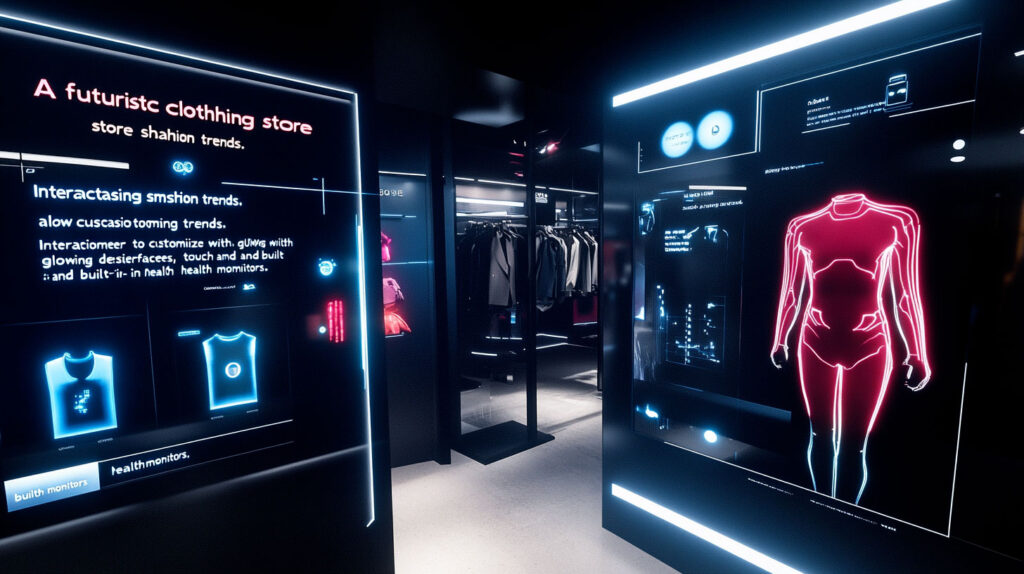
The smart clothing market is projected to grow exponentially in the coming years. Factors driving this include:
- Increasing Health Awareness: Men are more conscious of their well-being and seek tools that provide actionable data.
- Mainstream Tech Adoption: As people get accustomed to smart homes and smart cars, wearing smart clothing becomes the next logical step.
- Price Reductions: Like most technology, prices for e-textiles will likely drop as production scales, making them more accessible.
We’re already seeing major retailers carve out dedicated sections for wearable tech. As competition intensifies, consumers benefit from better designs, improved functionality, and a broader range of styles.
8. Conclusion
Smart Clothing for Men is more than just a passing trend; it’s a significant evolution in how we dress, perform, and interact with the world around us. By merging style with cutting-edge functionality, these garments open up a realm of possibilities—from monitoring health metrics to adjusting comfort levels in real time. Whether you’re an athlete aiming to optimize your performance, a professional seeking discreet tech solutions, or simply someone who loves innovative fashion, smart clothing has something to offer.
As the market continues to expand, we can expect greater collaboration between fashion designers and tech developers, resulting in pieces that are both aesthetically pleasing and technologically advanced. The shift towards sustainability also ensures that future developments in smart clothing consider their environmental impact. This synergy between form, function, and responsibility positions smart apparel as a compelling choice for the modern man.
9. Call to Action
Ready to transform your wardrobe? Start by adding one piece of Smart Clothing for Men—whether it’s a temperature-regulating jacket, a pair of tech-enhanced sneakers, or an intelligent workout shirt. Experience firsthand how these garments can elevate your daily life. If you want to stay updated on the latest smart clothing releases, tips, and exclusive offers, subscribe to our newsletter and follow our blog. Embrace the future of fashion and take your style to the next level today!
